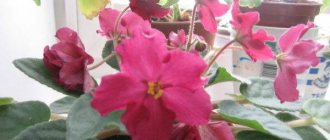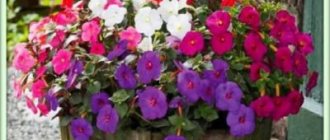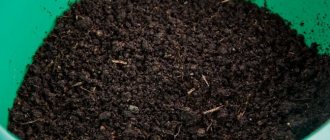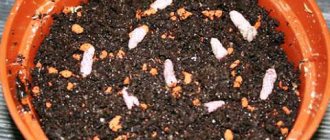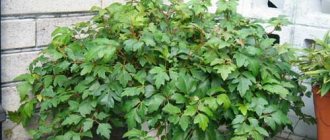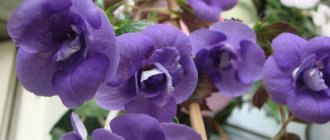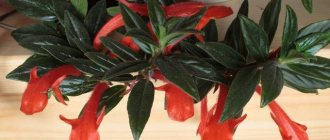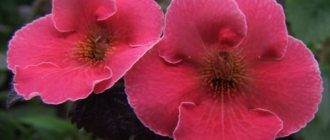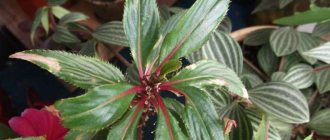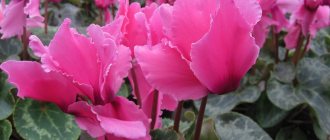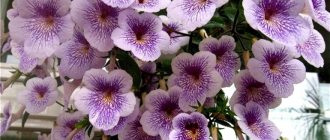The delicate flower Achimenes is a very popular home crop. In apartments and houses it is grown as a herbaceous perennial. Hanging baskets are purchased for it, since hanging varieties of the plant are often found. But, more often it is a bushy evergreen perennial with luxurious, abundant flowering in the summer.
The presented botanical description of the crop will allow us to better understand the agricultural technology of its cultivation at home. After all, only properly organized, complete care will create favorable conditions for flowering. Planting and propagation of the Achimenes flower is done in several ways. This process is also described in detail in this article. A variety of species and varieties will help you create a flower arrangement.
Look what the Achimenes flower looks like in the photo, illustrating its beauty and nobility:
Botanical description of Achimenes
According to the botanical description, Achimenes is classified as a member of the Gesnerieceae family. Basically, the genus is represented by perennial herbs with different appearance. Some look like shrubs, others are ampelous with creeping and climbing stems. The plant is native to South and Central America, where it grows in temperate subtropical zones. Most species are found in Mexico.
The rhizome of Achimenes is scaly and consists of rhizomes (deformed shoots). Some gardeners compare root tubers to pink light bulbs because of their similar shape. Achimenes rhizomes are excellent for vegetative propagation. When it is necessary to obtain new specimens, the root is divided into several parts and planted in new places.
The perennial stems are weak. They can be erect or drooping. The branching is weak, but this does not prevent Achimenes from creating beautiful bushes. The leaf blades, covered with small hairs, have a serrated edge. The reverse side of the sheet is painted in a bright color, for example, pink. The foliage is dense and lush, making an excellent backdrop for the tubular flowers during the flowering period.
Flowering occurs in summer. At this time, beautiful tubular buds with a spreading limb are formed. The corolla can have the most unexpected colors - yellow, blue, red, purple and others. Achimenes flowers are formed in the axils of leaf blades, one at a time or in pairs. The corolla is very large with an elegant tube and a 5-lobed cup.
Look at the Achimenes flower in the photo, which shows different forms of growing the plant in home gardens:
Variety of Achimenes varieties
There are many different varieties of Achimenes that are suitable for growing at home. This flower is especially loved by modern breeders. One of the famous contemporary botanists who is engaged in breeding new varieties is “Serge Saliba”. He is pleased to present to the public new, incredibly beautiful and colorful varieties of Achimenes for indoor cultivation.
There are several groups of varieties that can be divided by corolla color. The first and most picky about the conditions of detention is called Blue or light blue. Such plants have blue inflorescences of tubular flowers. The most famous varieties of this group:
- Achimenez "Blue Temptation" is a very finicky specimen. Its flowering begins already 4 months after planting. The perennial blooms with blue or blue flowers, about 5 cm in diameter.
- "Blue Swan" or "Blue Swan" - despite its name, the flowers look more like blue butterflies. The herbaceous bush at a young age has erect stems, which then droop under the weight of dense foliage.
Achimenes also occurs quite often with pink flowers. But such representatives of the genus are less picky, despite the fact that they are also tropical guests in the apartment. Typically, flower growers note that Achimenes of the Pink series blooms much more abundantly and longer - from spring to autumn. The most prominent representatives of the group can be considered the following:
- "Vie en Rose" is a plant with medium-sized light pink flowers. The throat of the bud is white or yellow, has a brown neck.
- "Terracotta" is a perennial that grows to a relatively large size. The flower has terracotta or red buds with a narrow edging of corolla petals. The throat of the tube is yellow. Most often, this variety is grown as an hanging plant.
- Achimenes "Double Pink Rose" is a luxurious hybrid with incredibly beautiful pink flowers. The double bud is very similar to roses. Flowering is abundant and long lasting - usually all summer and the first months of autumn.
- Achimenes "Pink Glory" - the flowers are very large, can reach 6-8 cm in diameter. The color of the petals is pure pink. The edges of the corolla are slightly corrugated, which gives the plant an even more unique appearance.
Also, a common group of varieties are plants with yellow flowers. Such perennials are relatively young hybrids. Most of them were bred by Serge Salib in the last decade. Let's look at a photo of the yellow Achimenes variety, which is suitable for creating a beautiful home decoration:
- The Saliba variety is a very young hybrid, one of the last ones bred by Serge. The flowers of this plant are very similar to roses - they are double with brighter edges of the corolla.
- The compact Achimenes cultivar 'Yellow English Rose' is a very common variety for home growing. Despite the fact that the hybrid was bred in 2012, over several years it has gained enormous popularity. The flowers of the plant are yellow, large, with wavy petals and very double. All this makes them as similar to roses as possible.
There are other colors of Achimenes that can be seen when growing a perennial in your home. For example, the Ehrenberga variety is very popular. Its representatives have straight, strong stems, up to 45 cm high. The plant is heavily pubescent with small hairs and has a lot of leaf blades. Flowering is abundant and long - all summer and autumn. Flowers reach 3 cm in diameter. They can be yellow or purple.
Achimenes 'Purple King' variety with purple flowers. It is one of the most popular domestic crops around the world. The flowers of the plant are very large and purple. The stems are often erect, but they can hang under the weight of buds and leaves during the active flowering period - from spring to autumn. Purple flowers of the Achimenes 'Shy Sun' variety. The corolla can have a gradient color from white to lavender. The flowers are semi-double. The variety is very popular due to its compact appearance and neatness.
Plant differences
Achimenes differ in the following characteristics:
- Type of shoots - there are types in which they grow upward (erect), and there are those in which they droop (ampeloid).
- Bush height - various species, varieties and hybrids form bushes with a height of 30 to 50 cm.
- The size of the buds is small, medium and large, reaching a diameter of 2.5 to 6 cm.
- The color scheme of the buds - the petals can be pink, purple, white, red, yellow, orange.
- Level of doubleness of flowers - petals are smooth, semi-double and double.
- Flower shape - during flowering, round, long, bell-shaped buds are formed.
Growing rules and care at home
Despite the fact that Achimenes is not such a finicky plant, you need to know some rules for its cultivation. At home, caring for perennials is simple and not particularly difficult. The most important thing in the life of a plant is high humidity, since it came to us from the hot subtropics. This applies not only to the soil, but also to the air. To maintain high humidity, some gardeners grow the plant near aquariums.
Achimenes loves light very much. But direct sunlight often injures it, leaving burns on the foliage and shoots. Therefore, under no circumstances place the perennial in the open sun. East or west windows are best. With strong shading, the saturation of the buds is lost and the stems are stretched. Even in winter it is not recommended to place the plant in a dark place.
The air temperature must be optimal. In summer it can fluctuate from 20 to 30 degrees Celsius. In autumn, the temperature is gradually reduced to 16 degrees. During the winter dormant period, Achimenes is kept in a room with humid air at a temperature of no more than 14 degrees. In summer, you can display the plant on a balcony, terrace or place it in the garden. The perennial is not afraid of drafts. The only thing that can harm him is sharp gusts of cold wind. Therefore, if you place an achimenes flower in the garden in the summer, then do it so that it is hidden from the winds. The plant does not tolerate sudden changes in temperature during the winter dormant period. Proper care at home guarantees lush flowering.
be organized so that the plant does not need moisture during the flowering period. Focus on the top soil layer. It should always remain moist. For irrigation, melt moisture at room temperature is used. Instead, you can purchase distilled or filtered water. It is not recommended to spray the Achimenes indoor plant, as the water leaves white spots on the foliage. During the winter dormancy period, watering is reduced to 1-2 procedures per month. In spring, their number is gradually increased to awaken. It is best to start reducing watering after the buds have faded.
Nutrient mineral compositions for flowering plants are used as fertilizers. Fertilizing is applied once every 2 weeks. You cannot overdo it with them and add organic matter, as this can easily provoke rotting of the perennial root system.
The pruning procedure can be carried out in spring and autumn. Spring sanitary intervention is needed in order to renew the bush. Also, at this time, you can remove fading shoots and cut cuttings for propagation of Achimenes. In autumn, they mainly remove faded flowers, leaves and stems and prepare the plant for the dormant period.
Temperature
For normal development of achimenes, the temperature should not be lower than 20 °C, optimally 22-23 °C. It does not tolerate sudden changes in temperature and cold drafts. In summer, it can be taken out to the balcony only if there are no large fluctuations in daily temperature (cold nights). With the onset of autumn, before the onset of the dormant period, the temperature begins to decrease.
The variety of shapes and colors of Achimenes never ceases to amaze
Transplantation and propagation of Achimenes
The most important stages of growing Achimenes are its transplantation and propagation at home. Both processes are not only simple, but also interesting for beginners and experienced gardeners. As an annual maintenance, you need to replant the plant. It is done very simply - by transferring it to another container. Achimenes rhizomes are very easily deformed if they are not replanted carefully. Therefore, follow the basic rules of procedure.
To begin with, we note that replanting is needed annually even if the perennial has begun to grow strongly. The root system - rhizomes - is located on the surface of the soil. Therefore, choose a flat but wide pot. Deep flowerpots will simply take up extra space in the house. Transshipment can be done closer to summer, when it grows. If the bush is neat, then it is replanted in the spring or at the end of winter - February, March. Before transplanting, the achimentes flower is watered generously with warm water. You need to remove it from the pot carefully so as not to accidentally damage the rhizomes or destroy the earthen lump.
Ready-made soil is suitable as a new mixture. If you want, you can collect the soil yourself using peat, sand, charcoal, turf and leaf soil. Fertilizers begin to be applied only 2-4 months after transplantation.
There are three ways to propagate the indoor plant Achimenes: seed, cuttings and rhizomes.
How to grow Achimenes from seeds?
Seeds help to obtain new varieties and are more often used by breeders. This planting material has a high germination rate, so it is used as often as vegetative propagation methods. Seeds are collected from your own plants or purchased at a flower shop. It is important to know that the seed propagation method does not preserve the maternal qualities of daughter perennials - the result in most cases will be unpredictable. Before you grow achimenes from seeds, you need to be prepared for the fact that the result may not be at all as expected.
To germinate the seeds of the Achimenes flower, use a moist substrate. A mixture of universal soil and peat is suitable. You can also use soil based on sand and leaf turf. Sowing is carried out at the end of winter or at the very beginning of spring. The most important thing is that the substrate always remains moist. Cover the plantings with transparent film and place the container in a warm, dark place. In about 2-3 weeks the first shoots will appear. In order for the root system to develop without problems, young plants dive. Perennials can be planted in permanent places after another 2-3 months. Now you can care for Achimenes seedlings like an adult plant.
How to propagate using cuttings?
Achimenes can be propagated using cuttings. They are cut from young shoots in the summer. You should not use flowering stems for this. Cuttings are taken from the tops. Some gardeners skillfully use leaves with petioles. The length of the stem should be at least 5-7 cm. The plant should be rooted in a nutrient substrate based on sand and peat, since this process is lengthy and after a month in water, the plantings may simply rot. The cuttings are covered with a transparent cap and placed in a warm place. Plantings take root in 30-35 days. To speed up this process, you need to create an additional heat source and use a growth stimulator. After the roots appear, the plant can be transplanted to a permanent place in a wide pot.
Method of propagation by rhizomes
The most common method of propagation is by Achimenes rhizomes; this procedure can only be carried out during the spring transshipment. Rhizomes are separated from the mother rhizome so that each part has a small shoot. They are placed in pre-prepared containers with a nutrient substrate. For soil, take peat, coconut fibers (you can find a special substrate in a flower shop) and river sand. All parts are mixed in a ratio of 3:1:1. It is important that the soil is laid out in layers: a drainage layer, humus and bone meal. Rhizomes are placed horizontally on the ground and sprinkled with soil. Plantings are watered and placed in a warm, well-lit place. After fresh sprouts appear, the transparent cap can be removed.
A plant grown using rhizome cuttings retains its maternal qualities and blooms in the year of planting. The seed method in this regard lags behind in efficiency - such perennials bloom in 1-2 years.
